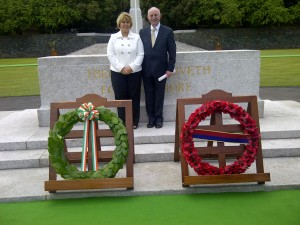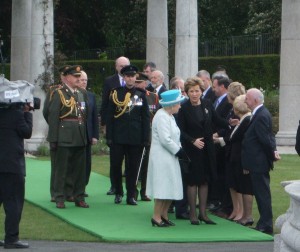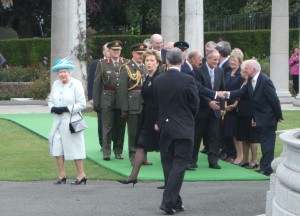Today, as Chairman of the Somme Association, I was in Dublin with Carol Walker, our Director, at the invitation of the Government of the Republic of Ireland.
Both unionist and nationalist politicians from Northern Ireland were among those present when The Queen honoured tens of thousands of Irishmen who died in the First World War. At a commemoration steeped in symbolism, Her Majesty laid a poppy wreath at the Irish National War Memorial Gardens in tribute to the almost 50,000 soldiers who died in the Great War. President Mary Mc Aleese then laid a twin wreath.
The ceremony at the gardens in Islandbridge, a site which fell into disrepair during the turbulent 1970s but has since been fully restored, seemed to symbolise the improved relationship between Britain and Ireland. The Queen was smiling slightly as she arrived at noon for the third engagement of the second day of her state visit to the Republic.
Opening the ceremony, the officer in charge of the cadet guard of honour announced the Queen’s name in Irish – Banríon Eilís a Dó – to the more than 500 attendees assembled along neat rows of garden chairs. A strong breeze buffeted a large Tricolour that stood at half-mast. Behind it, the Union flag flew alongside the three divisional flags of the British Legion and the light-blue standard of the United Nations.
After the UK national anthem was played, the monarch and the Duke of Edinburgh stood for a minute’s silence before a lone Irish army piper played a Scottish lament to the fallen followed by a trumpeting of the Last Post. The Irish national anthem, Amhran na bhFiann, was also played at the event. President Mary McAleese was accompanied by her husband, Martin.
Second World War veterans and members of the Irish military were among those present in the rows of seats laid out for the open-air ceremony. Dignitaries and special guests included the head of the Catholic Church in Ireland, Cardinal Sean Brady, the Presbyterian Moderator, Norman Hamilton and Jackie McDonald of the Ulster Defence Union.
Around 20 Orangemen were present, as were politicians from across the island including First Minister Peter Robinson, Alliance Leader David Ford, UUP Chief Tom Elliott, and the SDLP leader, Margaret Ritchie. Sinn Fein Deputy First Minister Martin McGuinness was unable to attend the service. Irish Environment Minister Phil Hogan , Finance Minister Michael Noonan and the mayors of Messines and nearby Heuvelland were also in attendance.
Following the wreath-laying, the Queen and the Duke of Edinburgh were shown the Guillemont Ginchy cross and illuminated manuscripts, created by stained glass artist Harry Clarke, in the granite room of the memorial containing the names of all the soldiers commemorated. They then met and chatted with guests before departing for their next engagement.
I was privileged to have been presented to The Queen by President Mary Mc Aleese, who told her of my role in the preparations for the occasion. I was then presented to His Royal Highness, Prince Philip, Duke of Edinburgh.
The renowned architect Sir Edwin Lutyens, who designed the Cenotaph in London, also designed the Islandbridge gardens and its structures, which were completed in the 1930s after the south of Ireland had gained independence from Britain.
The site contains an altar-like granite structure referred to as the War Stone inscribed with “Their Name Liveth for Evermore”, and the 30ft Guillemont Ginchy Cross, the wall behind which bears the words in Irish and English: “I ndil-chuimhne ar 49,400 Eireannach do thuir sa Chogadh Mhor 1914-1918 – To the memory of 49,400 Irish men who gave their lives in the Great War 1914-18”.
Following this I was invited with Carol to a special dinner in Leinster House with Government ministers and officials. We watched on one monitor Gerry Adams TD giving a speech to the Dail and then on a twin monitor The Queen’s Speech at the Banquet given in her honour at Dublin Castle. A truly unique occasion.


